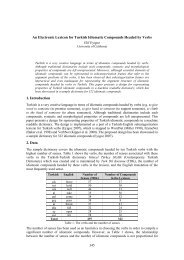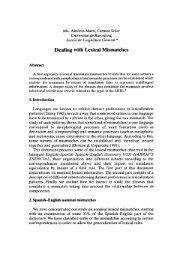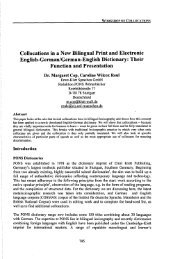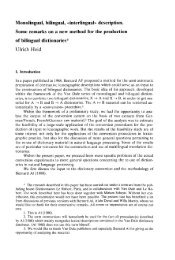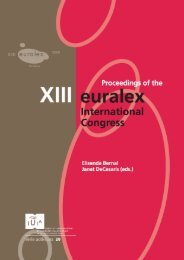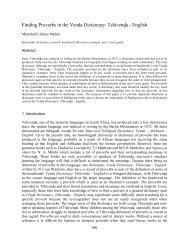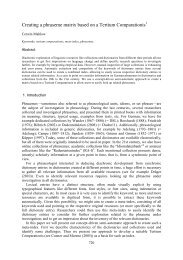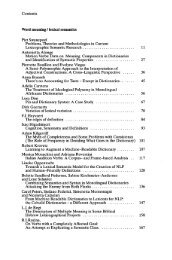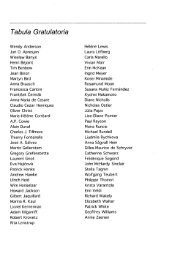Languaging-up the Dictionary Maker_ neologisms and ... - Euralex
Languaging-up the Dictionary Maker_ neologisms and ... - Euralex
Languaging-up the Dictionary Maker_ neologisms and ... - Euralex
You also want an ePaper? Increase the reach of your titles
YUMPU automatically turns print PDFs into web optimized ePapers that Google loves.
<strong>Languaging</strong>-<strong>up</strong> <strong>the</strong> <strong>Dictionary</strong> <strong>Maker</strong>:<br />
<strong>neologisms</strong> <strong>and</strong> dictionaries<br />
Marcel Thelen - Peter Starren<br />
1. General<br />
In this article wc will discuss a project on <strong>neologisms</strong> that we carried out at <strong>the</strong> Dutch<br />
State School of Translation <strong>and</strong> Interpreting in Maastricht. The aim of <strong>the</strong> project is<br />
to test a method for analyzing semantic developments in <strong>neologisms</strong> <strong>and</strong> to see what<br />
dictionaries do with <strong>neologisms</strong>. The project consists of an analysis of 47 words <strong>and</strong><br />
phrases in 13 different dictionaries. The total number of items of analysis (given<br />
<strong>and</strong>/or not given in <strong>the</strong>sc dictionaries) is 631. The words <strong>and</strong> phrases we analyzed are:<br />
asquish, action painter, action painting, aerobics, back<strong>up</strong>, biathlon, body-builder, conventional<br />
wisdom, crack <strong>up</strong>, crash course, decompress, deselect, dramedy, ecology,<br />
encounter gro<strong>up</strong>, e<strong>up</strong>henics, Eurobond, exlralinguistic, fallout, feedback, fingerprint,<br />
floating voter, free university, geep, generate, genetic engineering, gofer, greenhouse effect,<br />
hang<strong>up</strong>, happening, hatchback, hawk, headhunt, headhunler, hothouse effect, <strong>the</strong><br />
dp of <strong>the</strong> iceberg, immunodeficiency disease, in-crowd, in-depth, interface, irrelevant,<br />
jet-fatigue, jet-lag, jet syndrome, job-hop, kiss of life, <strong>and</strong> kneeroom. We used lhe following<br />
dictionaries:<br />
1. The Concise Oxford <strong>Dictionary</strong> of Current English (COD), 1964 (reprinted<br />
with corrections);<br />
2. The Advanced Learner's <strong>Dictionary</strong> ofCurrent English (ALD), 1968 (second<br />
edition/ninth impression);<br />
3. K. Ten Bruggencale Engels Woordenboek, Engels-Nedeti<strong>and</strong>s (Bruggencate),<br />
1970 (second impression of seventeenth edition);<br />
4. <strong>Dictionary</strong> of New English 1963-1972 (Barnhart), edited by Cl. Barnhart el<br />
al., 1973;<br />
5. Oxford <strong>Dictionary</strong> of Current Idiomatic English. Volume 1: Verbs with Prepositions<br />
& Articles (Idioms 1), edited by A. Cowie & R. Mackin, 1975;<br />
6. Webster's New Twentieth Century <strong>Dictionary</strong>, Unabridged (Webster's),<br />
1979;<br />
7. Longman <strong>Dictionary</strong> ofConlemporary English (LDoCE), 1981 (reprinted<br />
with corrections);<br />
8. Collins English <strong>Dictionary</strong> (Collins), 1982 (sixteenth impression);<br />
9. Oxford Advanced Learner's <strong>Dictionary</strong> of Current English (OALD), 1982<br />
(sixteenth impression);<br />
10. Oxford <strong>Dictionary</strong> of Current Idiomatic English. Volume 2: Phrase, Clause<br />
& Sentence Idioms (Idioms 2), edited by A. Cowie et al, 1984;<br />
11. Van Dale Groot Woordenboek Engels-Nederl<strong>and</strong>s (Van Dale), 1984;<br />
12. Collins Cobuild English Language <strong>Dictionary</strong> (Cobuild), 1987;<br />
13. 77ге Longman Register ofNew Words. Volume J (Ayto), edited by J. Ayto,<br />
1989.
392<br />
2. Dictionaries used<br />
The number of dictionaries we uscd is completely arbitrary, as our intention was not<br />
to give an exhaustive <strong>and</strong> conclusive analysis but ra<strong>the</strong>r to set <strong>up</strong> a method of analysis.<br />
On purpose, however, we included monolingual learners' <strong>and</strong> non-learners' dictionaries<br />
as well as bilingual or translation dictionaries, because we wanted to see<br />
which type of <strong>the</strong>se dictionaries is <strong>the</strong> best help for students of translation at lhe<br />
Dulch State School ofTranslation <strong>and</strong> Interpreting in Maastricht. We categorized <strong>the</strong><br />
dictionaries used in <strong>the</strong> following way:<br />
A) Monolingual Learners' Dictionaries:<br />
ALD (dict. nr. 2)<br />
Cobuild (dict. nr. 12)<br />
Idioms 1 (dict. nr. 5)<br />
Idioms 2 (dict. nr. 10)<br />
LDoCE (dict. nr. 7)<br />
OALD (dict. nr. 9)<br />
B) Monolingual Non-learners' Dictionaries:<br />
Ayto (diet. nr. 13)<br />
Barnharl (dict. nr. 4)<br />
COD (dict. nr. 1)<br />
Collins (dict. nr. 8)<br />
Webster's (dict. nr. 6)<br />
C) Bilingual or Translation Dictionaries:<br />
Bruggencate (dict. nr. 3)<br />
Van Dale (dict. nr. 11)<br />
We did not make a distinction between dictionaries of American English <strong>and</strong> dictionaries<br />
of British English (since nearly all of <strong>the</strong> above dictionaries contain both<br />
American English <strong>and</strong> British English), nor between dictionaries wilh «established»<br />
words <strong>and</strong> phrascs <strong>and</strong> dictionaries with new words <strong>and</strong> phrases, because we fell<br />
lhat this would be too detailed a distinction in view of <strong>the</strong> small number of dictionaries<br />
we used. The same goes for <strong>the</strong> distinction between idiomatic <strong>and</strong> non-idiomatic<br />
dictionaries. In fact, <strong>the</strong> idiomatic dictionaries we used are somewhat strange<br />
in this collection of dictionaries, on <strong>the</strong> one h<strong>and</strong> because we selected <strong>the</strong> items to<br />
be analyzed at r<strong>and</strong>om which means lhat it was purely by chance lhat we picked out<br />
idioms <strong>and</strong> lhat lheir number turned out to be ra<strong>the</strong>r small, <strong>and</strong> on <strong>the</strong> o<strong>the</strong>r h<strong>and</strong><br />
because <strong>the</strong>se diclionarics were helpful in a few cases only due to <strong>the</strong> fact that lhey<br />
contain idioms ra<strong>the</strong>r than non-idiomatic language. We never<strong>the</strong>less kept <strong>the</strong>m in<br />
our collection of dictionaries. <strong>Dictionary</strong> number 5 (Idioms 1) was <strong>the</strong> least helpful
393<br />
due to <strong>the</strong> nature of items incorporated in it, <strong>and</strong> <strong>the</strong>refore vve decided to keep it<br />
in our survey, but not to include it in our actual analysis.<br />
3. Selection of' words <strong>and</strong> phrases<br />
1 he words <strong>and</strong> phrases were selected at r<strong>and</strong>om. The only «criterion» for selection was<br />
that <strong>the</strong>y should be in use today. The point of departure for <strong>the</strong> actual selection<br />
was Barhnart (1973), i.e. we selected our items from this dictionary <strong>and</strong> only <strong>the</strong>n<br />
looked <strong>up</strong> <strong>the</strong>se items in <strong>the</strong> o<strong>the</strong>r dictionaries. Initially, we intended to take Ayto<br />
(1989) as a second point of departure <strong>and</strong> lo compare <strong>the</strong> two melhods, but <strong>the</strong>n we<br />
decided lo drop <strong>the</strong> latter, not only for practical reasons, but also because we felt lhal<br />
lhe firsl method was more promising. Of course, lhe lwo melhods differ in scope <strong>and</strong><br />
nature. Nol only will lhe words <strong>and</strong> phrases (to be) selected be different (at least, in<br />
mosi cases), but also <strong>the</strong> conclusions lo be drawn. The first method can give an answer<br />
to such questions as: «how many of lhe ilems selected are eventually incorporated in<br />
'established' dictionaries?>>, «how long does a neologism take lo be incorporated in 'establislied'<br />
dictionaries?>>, <strong>and</strong> «does lhe meaning (definition) of a neologism change<br />
from '<strong>Dictionary</strong> of New Words' lo 'established' dictionary?». Both <strong>the</strong> firsl <strong>and</strong> <strong>the</strong><br />
second method may explain why <strong>and</strong> in what way <strong>neologisms</strong> in a '<strong>Dictionary</strong> of New<br />
Words' are new <strong>and</strong> <strong>the</strong> reasons for <strong>the</strong>ir incorporation in such a dictionary.<br />
As mentioned before, because we selected our items at r<strong>and</strong>om, it was by pure<br />
chance thal we also selected idioms. As a result <strong>the</strong>ir number is small <strong>and</strong>. <strong>the</strong>refore,<br />
<strong>the</strong>y are perhaps negligible.<br />
4. Principles underlying <strong>the</strong> analysis<br />
ln our analysis we made a strict distinction between FORM <strong>and</strong> MEANING, <strong>and</strong> gave<br />
MEANING priority over FORM, basing ouserveles on lhe model of translation formulated<br />
in Larson (1984). Thus, we lrealed <strong>neologisms</strong> from <strong>the</strong> point of a translator/student<br />
of translalion. FORM only served as a point of «firsl recognilion» of a possible<br />
relaledness between diclionary ilems. The semantic analysis itself is based on a<br />
model of grammar thal was developed by Alinei (1974, 1980a, <strong>and</strong> 198()b) <strong>and</strong> applied<br />
<strong>and</strong> worked out somewhat furlher by Thelen (1980, 1983a, 1983b, 1987a, 1987c, <strong>and</strong><br />
1990), <strong>and</strong> lhat is called A Two-Cycle Model ofGraminar (TCM).<br />
In TCM, <strong>the</strong> grammar is doubted into a Lexical Cycle <strong>and</strong> a Sentence Cycle. The<br />
two cycles have identical rules <strong>and</strong> categories, which differ in scope only. The Lexical<br />
Cycle generates lexical ilems, <strong>and</strong> lhe Sentence Cycle sentences. The basic principle<br />
ofTCM is lhat a lexical item in fact is a shortcut of an underlying conceptual-syntactic<br />
structure (called Internalized Sentence or Phrase). The categories in this Internalized<br />
Sentence are identical lo lhe grammatical/syntactic categories of an actual senlence<br />
(called Externalized Sentence) in which this lexical item is present. The<br />
internalized Sentence of piano, for example, could be:<br />
INSTR /W!l SB PD OB /<br />
(where INSTR = Instrument, WH indicates relativization. SB = Subject, PD =<br />
Predicate <strong>and</strong> OB = Direct Object)
394<br />
which means that <strong>the</strong>re is an instrument on which a human being makes music. The<br />
underlining means that <strong>the</strong> part in question can actually occur, next to lhe lexical item<br />
piano itself, in an Externalized Sentence: «John is very fond of <strong>the</strong> piano on which he<br />
plays classical music». The Internalized Sentence of music hall could be:<br />
LOC /W/I SB PD OB /<br />
(where LOC = Locative, Location)<br />
<strong>and</strong> that of pianist:<br />
SB /WH PD OB /.<br />
All <strong>the</strong>se Internalized Sentences can —via a reversed application of transformations—<br />
be «reduced» to one <strong>and</strong> <strong>the</strong> same abstract conceptual-syntactic structure<br />
(called Lexical System):<br />
SB PD OB .<br />
All those lexical items belong to this same Lexical System whose Internalized Sentences<br />
have at least as Subject <strong>and</strong> as Predicate. This Lexical System<br />
belongs to several larger conceptual fields (called Lexical Domains): , <br />
<strong>and</strong> , i.e. in general all those lexical items belong to one <strong>and</strong> <strong>the</strong> same Lexical<br />
Domain whose Lexical System(s) have one conceptual-semantic feature in common,<br />
irrespective of its place <strong>and</strong> function in lhe structure of <strong>the</strong> respective Lexical Systems.<br />
The elements , , etc. are axiomatic conceptual-semantic<br />
features/components, i.e. features/components that, for <strong>the</strong> sake of analysis, are<br />
treated as primitives by axiom. Moreover, lhey are nol disclinctive features, but prototypical<br />
features. Toge<strong>the</strong>r with conceptual-syntactic categories <strong>the</strong>se axiomatic features<br />
form <strong>the</strong> input for <strong>the</strong> Lexical Cycle. The output of <strong>the</strong> Lexical Cycle, i.e. lexical<br />
items, forms <strong>the</strong> input for <strong>the</strong> Sentence Cycle.<br />
Ano<strong>the</strong>r important aspect of TCM is that of Componential Analysis, co<strong>up</strong>led<br />
with <strong>the</strong> notions of Exchange of Functions <strong>and</strong> Taxonomy. Lexical items are gro<strong>up</strong>ed<br />
toge<strong>the</strong>r in taxonomies, i.e. hierarchical structures with, from top to bottom, a hyperonym-hyponym<br />
or whole-part relation between <strong>the</strong> lexical items in question. Every<br />
lexical item generated by <strong>the</strong> Lexical Cycle can be decomposed into smaller conceptual-semantic<br />
components (Componential Analysis). An already generated lexical<br />
item can function as a conceptual-semantic component at a next lower level in a taxonomy<br />
(Exchange of Functions). What is important for TCM is that taxonomies are<br />
related to o<strong>the</strong>r taxonomies by means of <strong>the</strong> construct of Lexical System. This means,<br />
for example, that <strong>the</strong> taxonomy of «pianos» —via <strong>the</strong> Lexical System of SB <br />
PD OB — can be related to that of «playing», <strong>and</strong> that of «places for<br />
music», etc.<br />
The above principles of Conceptual-syntactic Categories, Lexical Systems, Taxonomies,<br />
<strong>and</strong> Lexical Domains are <strong>the</strong> four basic TCM principles for structuring <strong>the</strong><br />
(<strong>the</strong>oretical) lexicon. TCM takes dictionary definitions to be approximations of Internalized<br />
Sentences <strong>and</strong>, <strong>the</strong>refore, as <strong>the</strong> starling point for <strong>the</strong> structuring of <strong>the</strong><br />
lexicon.
395<br />
Although TCM requires a considerable number of data in order to be able to try<br />
<strong>and</strong> structure (well-defined parts of) <strong>the</strong> lexicon, <strong>and</strong> although in this project we only<br />
analyzed a relatively small number of data without even intending to structure <strong>the</strong><br />
lexicon, we found that lhe basic principles of TCM, especially those of Lexical System.<br />
Lexical Domain <strong>and</strong> Internalized Sentence, are very useful for <strong>the</strong> study of <strong>neologisms</strong><br />
<strong>and</strong> <strong>the</strong> comparison of dictionaries on this point. The above could mean, however,<br />
lhat <strong>the</strong>re is a serious drawback to our project: some of <strong>the</strong> Lexical Systems <strong>and</strong><br />
Lexical Domains we postulated for items can only be called «axiomatic» in lhe true<br />
sense. We can easily refute such criticism, because in lhe first place we are interested<br />
in a method ra<strong>the</strong>r than in conclusive results.<br />
The items selected from Barnhart served as items of comparison. Every item<br />
liom <strong>the</strong> o<strong>the</strong>r diclionaries (<strong>the</strong> compared item) with which lhe Barnhart item of<br />
comparison was compared was analyzed <strong>and</strong> categorized by means of lhe following<br />
criteria:<br />
FORM<br />
MEANING<br />
same form/same meaning<br />
same form/approximate meaning<br />
same form/different meaning<br />
approximate form/same meaning<br />
approximate form/approximate meaning<br />
approximate form/different meaning<br />
item of comparison NOT GIVEN<br />
+<br />
+<br />
+<br />
±<br />
+<br />
+<br />
where same meaning = same overall meaning<br />
i.e. <strong>the</strong> compared item in question has exactly <strong>the</strong><br />
same overall meaning as <strong>the</strong> item of comparison<br />
(wheiher or not resulting from a reversed application<br />
of transformations to <strong>the</strong> internalized Sentence<br />
or Phrase of lhe compared item), i.e. <strong>the</strong> compared<br />
item in question belongs to <strong>the</strong> same Lexical System<br />
as lhe item of comparison, <strong>and</strong> thus to <strong>the</strong> same<br />
Lexical Domain;<br />
approximate meaning = related overall meaning<br />
(a reversed application of transformations does not<br />
yield <strong>the</strong> same overall meaning), i.e. <strong>the</strong> item in<br />
question belongs to <strong>the</strong> same Lexical Domain;<br />
same form = <strong>the</strong> item in question has <strong>the</strong> same spelling, <strong>the</strong> same<br />
compounding <strong>and</strong> belongs to <strong>the</strong> same grammatical<br />
category, though <strong>the</strong>re may be a difference in grammatical<br />
subcategory (e.g. as with verbs: transitive vs<br />
intransitive);<br />
approximate form<br />
<strong>the</strong>re is a difference in grammatical category, spell-
396<br />
ing, <strong>and</strong>/or compounding, but thc form of lhe ilem<br />
of comparison is still recognizable/can still be derived.<br />
Even in cases where (on thc basis of <strong>the</strong>se principles) <strong>the</strong> meaning of a compared<br />
item is labelled <strong>the</strong> same (i.e. with <strong>the</strong> symbol «=») as that of thc item of comparison,<br />
may a precise semantic analysis yield meaning differences. This means lhat<br />
thcre may bc a (meaning) difference in conceptual-semantic contenl of a conceptualsyntactic<br />
category that is only of minor importance for <strong>the</strong> definition of lhe Lexical<br />
Syslem in question, e.g.:<br />
bndy-building:<br />
... to make <strong>the</strong> muscles grow<br />
... to make <strong>the</strong> muscles conspicuous.<br />
5. Items of comparison vs. compared items<br />
For a survey of <strong>the</strong> labelling of items, see Appendix (A), <strong>and</strong> for <strong>the</strong>ir semanlic analysis<br />
see Appendix (B). Ano<strong>the</strong>r example is to crack <strong>up</strong>. ln Barnharl il is defined as:<br />
«to cause to laugh or to laugh uncontrollably; convulse with laughter».<br />
Wc analyzed il as follows:<br />
LS: SB PD <br />
EVENT <br />
<strong>and</strong>/or<br />
SB PD MANN (CAUSE )<br />
lS:/SB /PD /EVENT/<br />
<strong>and</strong>/or<br />
/SB /PD MANN <br />
LD: , <br />
where LS = Lexical Syslem, IS = Internalized Sentence, LD = Lexical Domain, <strong>and</strong><br />
MANN = Manner. The o<strong>the</strong>r symbols speak for <strong>the</strong>mselves.<br />
In LDoCE, Collins, OALD, Idioms 2, <strong>and</strong> Cobuild, however, a definilion of «lo<br />
tell ajoke» is given. This was analyzed as:<br />
LS: SB PD OB MANN <br />
LD: .<br />
Ayto, finally gives <strong>the</strong> definition of «lo smoke <strong>the</strong> drug crack», which we analyzed as:<br />
LS: SB PD OB <br />
LD: . .<br />
Because in LDoCE, Collins, OALD, Idioms 2, <strong>and</strong> Cobuild crack is given (wilhoul<br />
<strong>up</strong>) we labelled <strong>the</strong> compared ilem «±» for «approximate form», <strong>and</strong> «~» for approximate<br />
meaning. As can be seen, <strong>the</strong> compared item (in lhese diclionaries) belongs lo
397<br />
lhc same Lexical Domain as <strong>the</strong> ilem of comparison in Barnhart, viz. , bul its<br />
Lexical System is different, viz. SB PD OB MANN , instead<br />
of SB PD EVENT <br />
<strong>and</strong>/or SB PD MANN (CAUSE ). That is why<br />
we labelled crack in <strong>the</strong>se dictionaries as «=». The situation is different with <strong>the</strong> compared<br />
item in Ayto: il belongs lo a completely different Lexical Domain, viz. ,<br />
or . Therefore we labelled it «*» for «different meaning». Its form was<br />
labelled «+» for «same form». In this way. we analyzed <strong>and</strong> labelled all 47 items.<br />
(>. Notes on use, style, etc. in <strong>the</strong> dictionaries used<br />
Por each item of comparison <strong>and</strong> each compared ilem we wrote down <strong>the</strong> «circumslantial»<br />
informalion given in <strong>the</strong> respective diclionaries, i.e. grammatical informalion.<br />
regisler. slyle. etc.. lhal is not part of lhe definition. For a sample of this information,<br />
see Appendix (C). Then we compared all <strong>the</strong>se bits of information.<br />
7. Sources of <strong>the</strong> dictionaries used<br />
Initially, we wanled to follow a similar procedure as with notes on use, style, etc.. for<br />
<strong>the</strong> sources given in <strong>the</strong> various dictionaries. This turned out to be ra<strong>the</strong>r difficult, because<br />
only in Barnhart <strong>and</strong> Ayto sources are given for every item separately. In <strong>the</strong><br />
olher dictionaries whole, undifferentiated lists of sources are given in lheir introductory<br />
parts, so lhal it was not possible to trace a source for every single item. Therelore,<br />
vve decided to cancel this part from our project.<br />
The only thing to be said here is that <strong>the</strong> two diclionaries mentioned use a variety<br />
of sources (English as well as American) of all possible types, including books,<br />
newspapers, etc.<br />
8. Results<br />
Before we actually discuss some of <strong>the</strong> results of our project, we should emphasize<br />
that, because of lhe very small number of diclionaries <strong>and</strong> items analyzed, <strong>the</strong>se results<br />
can only be called tentative, <strong>and</strong> nol statistically significant.<br />
As mentioned before, <strong>the</strong> items from Barnhari have been labelled «items of<br />
comparison». <strong>and</strong> lhe ilems from <strong>the</strong> olher dictionaries «compared items». We divided<br />
lhe lime span in which lhe diclionaries appeared into two major parts: lhe time<br />
before Barnhart <strong>and</strong> <strong>the</strong> lime after Barnhart (see Appendices (D) <strong>and</strong> (E)). When we<br />
look at <strong>the</strong> time before Barnhart, we see lhal 32 compared items (notably in COD.<br />
ALD, <strong>and</strong> Bruggencale), resemble, one way or <strong>the</strong> o<strong>the</strong>r, ilems in Barnhart (or putting<br />
it differently, lhat 32 items of comparison from Barnhart already existed before<br />
<strong>the</strong>y were actually incorporated in this dictionary). The least interesting of <strong>the</strong>se ilems<br />
from <strong>the</strong> point of semantic development— are, of course, lhose with thc same form<br />
<strong>and</strong> <strong>the</strong> same meaning: feedback (COD), hawk (Bruggencale). <strong>and</strong> in-depih (Bruggencate).<br />
Il is striking though thal <strong>the</strong>se items were incorporated in Barnhart as being<br />
new words, whereas <strong>the</strong>y are nol. The most interesting of lhe olher 29 compared
398<br />
items are 1) those that have lhe same form (as <strong>the</strong> item of comparison) <strong>and</strong> an approximate<br />
meaning, 2) those that have an approximate form <strong>and</strong> <strong>the</strong> same meaning,<br />
<strong>and</strong> 3) those that have an approximate form <strong>and</strong> an approximate meaning. These<br />
items are respectively:<br />
1) ecology (COD, ALD, Bruggencate),//«#e/7?riw/ (COD, ALD, Bruggencate),<br />
generate (COD, ALD, Bruggencate). happening (COD,<br />
ALD, Bruggencate), irrelevant (COD, ALD, Bruggencate);<br />
2) asq11ish (Bruggencate), back<strong>up</strong> (Bruggencate). floating voter (COD,<br />
ALD, Bruggencate);<br />
3) fallout (Bruggencate),/eedftacA: (Bruggencate).<br />
Of <strong>the</strong>se items, those under (2) are <strong>the</strong> least interesting, simply because <strong>the</strong>y<br />
have <strong>the</strong> same meaning. The reason for Barnhart to incorporate <strong>the</strong>se items as new<br />
words may have been thcir «new» FORM. More interesting are <strong>the</strong> o<strong>the</strong>r two gro<strong>up</strong>s,<br />
i.e. ( 1 ) <strong>and</strong> (3). These Barnhart items of comparison clearly differ somehow in meaning<br />
from <strong>the</strong> corresponding compared items, <strong>and</strong> <strong>the</strong>refore Barnhart was correct to<br />
incorporate <strong>the</strong>m as new. The semantic development that look place here (see Appendix<br />
(B)) can be described as follows:<br />
a) <strong>the</strong> Lexical System of <strong>the</strong> item of comparison is different from that of<br />
<strong>the</strong> compared item, <strong>and</strong> a generalization of axiomatic features (<strong>the</strong><br />
conceptual-semantic content) has taken place: ecology, fingerprint,<br />
fallout, feedback;<br />
b) <strong>the</strong> Lexical System of<strong>the</strong> item of comparison isdifferent from thal oflhe<br />
compared item, <strong>and</strong> a specialization of axiomatic features (lhe conceptual-semantic<br />
content) has taken place: generate, happening, irrelevant.<br />
Because of <strong>the</strong> small number of dictionaries involved here, it did not make much<br />
sense to say anything about <strong>the</strong> three types of dictionary in this respect.<br />
When we look at <strong>the</strong> time after Barnhart (Appendix (E)), we see <strong>the</strong> following.<br />
First take all <strong>the</strong> cases where <strong>the</strong> meaning of <strong>the</strong> compared items incorporated in <strong>the</strong><br />
various dictionaries is exactly <strong>the</strong> same as that of <strong>the</strong> item of comparison, irrespective<br />
of FORM. Their total number per type of dictionary is:<br />
Monolingual Learners'<br />
Dictionaries (4 dicts.) 46 (average per dictionary: 11.5)<br />
Monolingual Non-learners'<br />
Dictionaries (3 dicts.) 40 (average per dictionary: 13.3)<br />
Bilingual or Translation<br />
Dictionaries (1 dict.) 30 (average per dictionary: 30)<br />
If at all significant, one might conclude from <strong>the</strong>se total numbers that Monolingual<br />
Learners' Dictionaries do better as far as <strong>the</strong> incorporation of new words is concerned,<br />
but when one looks at <strong>the</strong> average numbers per type of dictionary, one is lead<br />
to conclude that Bilingual or Translation Dictionaries do better. When one looks at<br />
<strong>the</strong> various dictionaries individually, <strong>the</strong>n Van Dale comes out best.
399<br />
More interesting in this respect are 1) those cases where <strong>the</strong> meaning of <strong>the</strong><br />
compared items incorporated in <strong>the</strong> various dictionaries is only an approximation of<br />
that of <strong>the</strong> item of comparison (irrespective of FORM), <strong>and</strong> 2) those cases where <strong>the</strong><br />
meaning of <strong>the</strong> compared items incorporated in <strong>the</strong> various dictionaries is completely<br />
different (again, irrespective of FORM). The situation is <strong>the</strong> following:<br />
1) approximate meaning<br />
Monolingual Learners'<br />
Dictionaries (4 dicts.)<br />
Monolingual Non-learners'<br />
Dictionaries (3 dicts.)<br />
Bilingual or Translation<br />
Dictionaries (1 dict.)<br />
21 (average per dictionary: 5.25)<br />
11 (average per dictionary: 3.6)<br />
3 (average per dictionary: 3)<br />
2) different meaning<br />
Monolingual Learners'<br />
Dictionaries (4 dicts.) 5 (average per dictionary: 1.25)<br />
Monolingual Non-learners'<br />
Dictionaries (3 dicts.) 6 (average per dictionary: 2)<br />
Bilingual or Translation<br />
Dictionaries (1 dict.) 2 (average per dictionary: 2)<br />
lt appears that, on <strong>the</strong> whole, Bilingual or Translation Dictionaries (in this case<br />
Van Dale) are more precise when it comes down to incorporating new meanings, <strong>and</strong><br />
as far as this is concerned, <strong>the</strong>y are more helpful to students of translation than any<br />
o<strong>the</strong>r dictionary. For <strong>the</strong> semantic analysis of <strong>the</strong>se items we refer to Appendix (B).<br />
For figures on Notes on use, style, etc., we refer to Appendix (C). A discussion<br />
of <strong>the</strong>se would take <strong>up</strong> too much space here. We think that <strong>the</strong>se figures speak for<br />
<strong>the</strong>mselves.<br />
9. Conclusions<br />
The results we achieved <strong>and</strong> <strong>the</strong> interpretations we gave to <strong>the</strong>m may seem simple<br />
repetitions of what has long been said <strong>and</strong> known about <strong>neologisms</strong> <strong>and</strong> <strong>the</strong>ir semantic<br />
development. Yet we feel that <strong>the</strong> method we applied in our project may be useful<br />
for a student of translation/a translator to assess <strong>the</strong> changed meaning in <strong>neologisms</strong><br />
in <strong>the</strong> act of translating. Besides, it proved useful for comparing various<br />
dictionaries on <strong>the</strong> point of <strong>neologisms</strong>. Therefore, we think that this method is very<br />
useful <strong>and</strong> deserves elaboration.
400<br />
The semantic analysis we formulated for our items of investigation may not yet<br />
be precise enough <strong>and</strong> be in need of fur<strong>the</strong>r specification. This may be due to <strong>the</strong><br />
small number of items <strong>and</strong> to <strong>the</strong> fact that <strong>the</strong>y were selected at r<strong>and</strong>om. A first preselection<br />
of morc items in well-defined parts of <strong>the</strong> lexicon may yield better results.<br />
Of all <strong>the</strong> dictionaries we analyzed, <strong>the</strong> Bilingual or Translation <strong>Dictionary</strong> Van<br />
Dale comes out best in <strong>the</strong> field of <strong>neologisms</strong>, not only because it incorporates more<br />
items of comparison (= <strong>neologisms</strong>) than <strong>the</strong> o<strong>the</strong>r dictionaries, but also because it is<br />
stricter as far as <strong>the</strong>ir meaning is concerned. This is not at all surprising since it does<br />
not have to give monolingual meaning definitions but foreign language equivalents<br />
only. Of <strong>the</strong> monolingual dictionaries, <strong>the</strong> Monolingual Learner's <strong>Dictionary</strong> Cobuild<br />
scores be.st. For a student of translation, <strong>the</strong>se two dictionaries seem to be <strong>the</strong> best<br />
help when it comes down to translating <strong>neologisms</strong>, <strong>and</strong> this in <strong>the</strong> following order:<br />
first Van Dale, <strong>the</strong>n Cobuild.<br />
10. Epilogue<br />
Again, <strong>the</strong>se results are tentative <strong>and</strong> pertain only to <strong>the</strong> dictionaries <strong>and</strong> data we<br />
analyzed. Yet we hope that <strong>the</strong>y may be useful for lexicographers.<br />
APPENDIX (A): labelling of items<br />
1964 1968 1970 1973 1975 1979 1981 1982 1982 1984 1984 1987 1989<br />
1 2 3 4 5 6 7 8 9 10 11 12 13<br />
asquish _ - ±/= + - +/= - ±1= - - ±/= - -<br />
action painter<br />
+ -<br />
action painting<br />
+<br />
-+ - - - - - -<br />
+ + + + + -<br />
aerobics<br />
-<br />
+ +<br />
-<br />
- - - -<br />
+ +<br />
back<strong>up</strong><br />
-<br />
- - +/= + + + + + - + + +1*<br />
biathlon - + + +<br />
+ - -<br />
body-builder<br />
+ - - +/= + + -<br />
conventional wisdow<br />
- - -<br />
+ +<br />
+ +<br />
- - - -<br />
crack <strong>up</strong> + - - + ±/= ±/= + +1*<br />
crash course<br />
+ - - - + ±/= ±/= + + + -<br />
decompress + - + + + +/* ±ІФ +<br />
deselect<br />
+<br />
- - - - - - - - - - - +1*<br />
dramedy +<br />
ecology +/= +<br />
+/= +/= +/=<br />
+/=<br />
encounter gro<strong>up</strong><br />
+<br />
±1= + + - -<br />
+<br />
e<strong>up</strong>henics<br />
-<br />
+<br />
- - - Eurobond<br />
+ +<br />
- -<br />
extralinguistic<br />
+ - - - - - - - -<br />
llout<br />
- ±/» + +/= +/= + +/=<br />
feedback +<br />
-<br />
- +/= + ±1= + + +/= +/= - + +<br />
fingerprint +/= +/= +/= + +/= + +/= - + floating voter ±1= ±1= ±/= +<br />
- ±/= + ±/= ±/= + +<br />
- -<br />
- I
401<br />
free university - - - + - - - - + -<br />
-<br />
geep<br />
- - + - - - - + -<br />
generate -<br />
+ - +/= + -<br />
genetic engineering - - - + - - + - - + +<br />
gofer - + + - - - - +1* +<br />
hang<strong>up</strong> - - + + + + + - + +<br />
greenhouse effect - - + - - + - - + +<br />
-<br />
happening +/= + + + - +<br />
hatchback _ _ - + + + + - + +<br />
-<br />
hawk _ _ + + + + + + + + +<br />
headhunt +<br />
headhunter + + +1* +1* - + +1* -<br />
hothouse effect - -<br />
-<br />
+<br />
- -<br />
-<br />
-<br />
- + -<br />
lhe tip of <strong>the</strong> iceberg - + - - + - + + +<br />
-<br />
immunodeficiency<br />
disease +<br />
in-crowd - - - + - - - - - + -<br />
in-depth - + + + + + + + + +<br />
interface<br />
- +ІФ + + + + + - + +<br />
-<br />
irrelevant +/= + +/= +/= +/= +<br />
-<br />
jet fatigue - - - + - - - - - -<br />
jet-lag<br />
- - + - - + - + +<br />
jet syndrome<br />
- - + - - - - - -<br />
job-hop - - + - -<br />
- - - -<br />
kiss of life - _ + _ - +1* + + +<br />
kneeroom +<br />
APPENDIX (B): semantic analysis of items of comparison <strong>and</strong> compared items<br />
Note: for this analysis <strong>the</strong> <strong>Dictionary</strong> of New English (Barnhart) is <strong>the</strong> point of departure.<br />
For <strong>the</strong> o<strong>the</strong>r dictionaries goes that —if <strong>the</strong>y give <strong>the</strong> Barnhart items at all in<br />
whatever form— only <strong>the</strong> differences from Barnhart are recored.<br />
asquish, «squishing»<br />
LS: SB PD OB <br />
IS: /SB.N. / WH IS[PD OB ]<br />
LD: <br />
action painter, «an artist who produces action paintings»<br />
action painting, «a style of painting emphasizing spontaneous expression by splashing<br />
or dripping paint on <strong>the</strong> canvas or by using broad, vigorous brush strokes»<br />
LS: SB PD OB <br />
MANN <br />
IS: SB AVH PD OB MANN / (action painter)
402<br />
IS: /SB 'human, artist> «'S»/ PD /«OF» OB / MANN (action<br />
painting)<br />
LD: <br />
aerobics, «a system of building <strong>up</strong> lhc body by means of exercises which develop <strong>the</strong><br />
use of oxygen by <strong>the</strong> body»<br />
LS: SB PD OB <br />
MEANS <br />
IS: MEANS AVHSB PD OB /<br />
LD: <br />
back<strong>up</strong>, «one kept in reserve as a substitute or for assistance»<br />
LS: SB PD <br />
OB GOAL <br />
IS: OB AVH PD PASSIVE SB /<br />
LD: «general»<br />
DICT. 13:<br />
LS: SB PD OB SOURCE <br />
DEST. GOAL <br />
IS: /SB >...>/PD /OB SOURCE DEST. /<br />
LD: <br />
biathlon, «a sports event combining a contest in cross-country skiing <strong>and</strong> file shooting»<br />
LS: SB PD EVENT <br />
IS: EVENT/WHSBPD /<br />
LD: <br />
body-builder, «a person who develops <strong>and</strong> streng<strong>the</strong>ns <strong>the</strong> body by systematic exercise<br />
<strong>and</strong> diet»<br />
LS: SB PD OB <br />
MEANS <br />
IS: SB /WH PD OB MEANS /<br />
LD: , <br />
conventional wisdom, «<strong>the</strong> generally accepted attitude or opinion; popular belief»<br />
LS: ...<br />
IS: ...<br />
LD: <br />
crack <strong>up</strong>, «to cause to laugh or to laugh uncontrollably; convulse with laughter»<br />
LS: SB PD EVENT <br />
<strong>and</strong>/or<br />
SB PD MANN (CAUSE )<br />
IS: /SB /PD /EVENT/<br />
<strong>and</strong>/or<br />
/SB /PD MANN <br />
LD: ,
403<br />
DICTs. 7, 8, 9,10, 12:<br />
LS: SB PD OB MANN <br />
LD: <br />
DICT. 13:<br />
LS: SB PD OB <br />
LD: , <br />
crash course fnot in DICT. OF NEW ENGL.J<br />
«def.» in DICT. 3: «spoed-»<br />
def. in DICT. 7: «markcd by a very great effort to reach quickly <strong>the</strong> desired<br />
results»<br />
LS: SB PD OB <br />
IS: OB /WHPD PASSIVESB /<br />
or<br />
/OB.N. /WH lS <br />
LD: , <br />
decompress lnot in DlCT. OF NEW ENGL.]<br />
def. in DICT. 13: «to rid oneself of feelings of tension <strong>and</strong> anxiety»<br />
LS: SB PD OB <br />
SOURCE <br />
where SB = SOURCE <br />
IS: /SB /PD
404<br />
DICTs. 1,2,3, 6,7,8,9,11, 12:<br />
LS: ... «biological systems»<br />
IS: ...<br />
LD: <br />
encounter gro<strong>up</strong>, «a gro<strong>up</strong> of people taking part in sensitivity training»<br />
LS: SB PD <br />
EVENT <br />
IS: SB AVH PD EVENT /<br />
LD: , , <br />
e<strong>up</strong>henics, «a science dealing with ways of improving <strong>the</strong> human race by technological<br />
means, such as organ transplantation, pros<strong>the</strong>tics, <strong>and</strong> genetic engineering»<br />
LS: ...<br />
IS: ...<br />
LD: , <br />
Eurobond, «a bond issued by an American or o<strong>the</strong>r non-European corporation for<br />
sale in European countries»<br />
LS: ...<br />
IS: ...<br />
LD: <br />
extralinguistic, «outside <strong>the</strong> province of language or linguistics»<br />
LS: ...<br />
IS: ...<br />
LD: , <br />
fallout, «a by-product or residue ofsomething, usually unexpected»<br />
LS: SB PD OB <br />
IS: OB AVHPD PASSIVESB /<br />
LD: <br />
DICTs. 3, 6, 7, 8, 9,12:<br />
LS: SB PD OB <br />
IS: OB /WH PD PASSIVE SB /<br />
LD: <br />
feedback, «a reciprocal effect of one person or thing <strong>up</strong>on ano<strong>the</strong>r; a reaction or response<br />
that modifies, corrects, etc., <strong>the</strong> behavior of that which produced <strong>the</strong> reaction<br />
or rcsponse»<br />
LS: ...<br />
IS: ...<br />
LD: <br />
DICTs. 3, 8, 9:<br />
LS: ...<br />
IS: ...<br />
LD:
405<br />
fingerprint, «a distinctive identifying mark, trace, or impression»<br />
LS: SB PD OB <br />
IS: OB AVHSB PD /<br />
LD: <br />
DICTs. 1, 2, 3, 6, 7, 9,12:<br />
LS: SB PD OB <br />
IS: OB AVHSB PD /<br />
LD: <br />
floating voter, «a voter who is not committed to any political party, c<strong>and</strong>idate, or issue;<br />
an undecided voter»<br />
LS: ...<br />
IS: ...<br />
LD: , <br />
free university, «an independent college or university organized chiefly by students to<br />
study subjects of interest to <strong>the</strong>m without <strong>the</strong> usual academic restrictions of grades or<br />
credits»<br />
LS: ...<br />
IS: ...<br />
LD: <br />
generate, «to derive or produce (a grammatical sentence) from more basic forms by<br />
a set of rules of operation <strong>and</strong> transformation»<br />
LS: SB PD OB ...<br />
lS:/SB /PD /OB .../<br />
LD: <br />
DICTs. 1, 2, 3, 6, 7, 9,11, 12:<br />
LS: SB PD OB <br />
lS:/SB /PD /OB /<br />
LD: <br />
genetic engineering, «1 <strong>the</strong> scientific alteration of genes or genetic material to produce<br />
desirable new traits in organisms or to eliminate undesirable ones.<br />
2 any form of human intervention in hereditary processes to alter <strong>the</strong> character of nature<br />
of an organism»<br />
LS: SB PD OB <br />
GOAL <br />
IS: /SB «'S>>/PD «OF» OB /GOAL /<br />
LD: <br />
geep, «<strong>the</strong> offspring of a goat <strong>and</strong> a sheep»<br />
LS: ...<br />
IS: ...<br />
LD: <br />
greenhouse effect, «<strong>the</strong> absorption <strong>and</strong> retention of <strong>the</strong> sun's infrared radiation in <strong>the</strong>
406<br />
earth's atmosphere, resulting in an increase in lhe temperature of <strong>the</strong> earth's surface.<br />
The greenhouse effect is due to <strong>the</strong> accumulation ofcarbon dioxydc <strong>and</strong> water vapor<br />
often caused by a cold-air mass trapping a warm-air mass underneath il much as <strong>the</strong><br />
glass of a greenhouse traps underneath it <strong>the</strong> air that is heated by lhe sun»<br />
LS: ...<br />
IS: ...<br />
LD: <br />
gofer, «an office assistant whose duties include running err<strong>and</strong>s for <strong>the</strong> staff»<br />
LS: SB PD OB BENEFICIARY<br />
IS: SB AVI/ PD OB BENEFICIARY /<br />
LD: <br />
DICTs. 2, 3, 11:<br />
LS: SB PD OB <br />
IS: OB WIIPD PASSIVESB /<br />
LD: <br />
<br />
hang<strong>up</strong>, «1 a psychological or emotional problem. 2 any problem or difficulty, especially<br />
that causes annoyance or irritation»<br />
LS: ...<br />
IS: ...<br />
LD: <br />
happening, «a spontaneous or improvised public performance, display, spectacle, or<br />
<strong>the</strong> like, often involving <strong>the</strong> audience or spectators»<br />
LS: ...<br />
IS: ...<br />
LD: <br />
DICTs. 1, 2, 3, 6, 9,12:<br />
LS: ...<br />
IS: ...<br />
LD: <br />
hawk, «a person who favors war or advocates military solutions in a conflict. To be or<br />
act as a hawk; be hawkish»<br />
LS: ...<br />
IS: ...<br />
LD: , <br />
headhunt, «to recruit executives for a corporation [v.t., v.i.]; an instance of headhunting»<br />
headhuntcr, «one who engages in headhunting, as a personnel agent or management<br />
consultant»<br />
LS: Lit.: SB PD OB , «hunt (for) people, kill <strong>the</strong>m<br />
<strong>and</strong> separate <strong>the</strong>ir heads from <strong>the</strong>ir bodies»<br />
LS: SB PD OB BENEFICIARY <br />
IS:/5/i '...>/PD /OB BENEFICIARY l (headhunt, v.t.)<br />
/SB /PD OB /BENEFICIARY ../(headhunt, v.i.)
407<br />
/SB «'S»/ PD /«OF» OB /BENEFIClARY / (headhunt,<br />
n. from v.t.)<br />
/SB
408<br />
irrelevant, «having no bearing on issues that are current»<br />
LS: ... «contemporaneity»<br />
IS: ...<br />
LD:
409<br />
action painting<br />
aerobics<br />
back<strong>up</strong><br />
biathlon<br />
body-builder<br />
conventional wisdom<br />
1, 2, 3, 5, 10, 13: item not given<br />
6, 7, 8, 9, 11, 12: no notes<br />
4) compare DRIP PAINTING<br />
1, 2, 3, 5, 7, 8, 9, 10, 13: item not given<br />
4) n. Also used attributively, [from <strong>the</strong> adjective aerobic.<br />
applied to organisms that thrive only in <strong>the</strong> presence of<br />
oxygen...]<br />
11) <br />
12) N. UNCOUNT<br />
1, 2, 5, 10: item not given<br />
3) Am.; zn. & bn.<br />
4) n.<br />
6) n.<br />
7) n.<br />
8) n. Chiefly U.S. [also] (as modifier)<br />
9) n. (colloq.)<br />
11) <br />
12) N. UNCOUNT<br />
13) verb<br />
1, 2, 3, 5, 7, 9, 10, 12, 13: item not given<br />
4) n.<br />
6) n.<br />
8) n. Sport<br />
11) <br />
1, 2, 3, 5, 6, 7, 9, 10, 13: item not given<br />
4) n.<br />
8) body building: n.<br />
11) <br />
12) N. UNCOUNT<br />
1, 2, 3, 5, 7, 8, 9, 10, 13: item not given; 4, 6: no notes<br />
11) 1.1 [= adj. combined with noun]<br />
12) PHR: USED S/O/C<br />
where <strong>the</strong> numbers indicate lhe various dictionaries<br />
Total number of "NO NOTES" : 32<br />
Number of "NO NOTES" in <strong>the</strong> various dictionaries:<br />
1) COD<br />
2) ALD<br />
3) Bruggencate<br />
4) Barnhart<br />
5) Idioms 1<br />
2<br />
0<br />
10<br />
5<br />
0
410<br />
6) Webster's<br />
7) LDoCE<br />
8) Collins<br />
9) OALD<br />
10) Idioms 2<br />
11) Van Dale<br />
12) Cobuild<br />
13) Ayto<br />
TOTAL<br />
Number of "NO NOTES" per type of dictionary:<br />
3<br />
2<br />
2<br />
4<br />
0<br />
3<br />
1<br />
0<br />
32<br />
Monoligual Learners'<br />
Dictionaries 7<br />
Monolingual Non-learners'<br />
Dictionaries 12<br />
Bilingual or Translation<br />
Dictionaries<br />
TOTAL<br />
Types of Notes:<br />
13<br />
32<br />
a) grammatical (total: 202)<br />
b) register (total: 20)<br />
c) style (total: 25)<br />
d) language variety (total: 13)<br />
e) explanatory information (total: 27)<br />
Types of notes in <strong>the</strong> various dictionaries:<br />
DICTIONARY<br />
a b c d e<br />
TOTAL<br />
1) COD 6 2 0 0 3 11<br />
2) ALD 7 1 0 0 0 8<br />
3) Bruggencate 3 2 0 2 0 7<br />
4) Barnhart 32 1 5 5 14 57<br />
5) Idioms 1 2 0 1 0 1 4<br />
6) Webster's 19 3 2 0 2 26<br />
7) LDoCE 18 1 2 1 0 22<br />
8) Collins 26 3 3 1 0 33<br />
9) OALD 15 0 3 0 0 18<br />
10) Idioms 2 6 0 1 0 2 9<br />
11) Van Dale 31 7 7 3 2 50<br />
12) Cobuild 31 0 0 0 0 31<br />
13) Ayto 6 0 1 1 3 11<br />
TOTAL 202 20 25 13 27 287
411<br />
Types of noles per type of dictionary:<br />
TYPE OF DICTIONARY a b c d e TOTAL<br />
Monolingual Learners'<br />
Dictionaries<br />
Monolingual Non-learners'<br />
Dictionaries<br />
Bilingual or Translation<br />
Dictionaries<br />
TOTAL<br />
79 2 7 1 3 92<br />
89 9 11 7 22 138<br />
34 9 7 5 2 57<br />
202 20 25 13 27 287<br />
APPENDIX (D): item ofcomparison already existing before Barnhart<br />
1: given in Barnhart<br />
item of comparison dict. labelling<br />
asquish 3 ±/=<br />
back<strong>up</strong> 3 ±1=<br />
ecology 1 +/=<br />
2 +/=<br />
3 +/=<br />
fallout 3 +1<br />
feedback 1 +<br />
3 +/=<br />
fingerprint 1 +/=<br />
2 +/=<br />
3 +/=<br />
floating voter 1 +/=<br />
2 +/=<br />
3 ±/=<br />
generate 1 +/=<br />
2 +/=<br />
3 +/=<br />
gofer 1 +1*<br />
3 +M<br />
happening 1 +/=<br />
2 +/=<br />
3 +/=<br />
hawk 3 +<br />
headhunter 1<br />
2 +/*<br />
3
412<br />
in-depth<br />
interface<br />
irrelevant<br />
kiss of life<br />
3 +<br />
3 +1*<br />
1 +/=<br />
2 +/=<br />
3 +/=<br />
3 +/*<br />
Dict. 1: Dict. 2: Dict. 3:<br />
+/= 5x +/« 5x +/= 6x<br />
+ lx + Ox + 2x<br />
±1= lx ±1= lx +/= 3x<br />
+/* 2x +/* lx +/* 4x<br />
±/= Ox ±/= Ox ±1* lx<br />
total 9x total 7x total 16x<br />
Dict. 1 = COD (= monolingual non-learner's dictionary)<br />
Dict. 2 = ALD (= monolingual learner's dictionary)<br />
Dict. 3 = Bruggencate (= bilingual or translation dictionary)<br />
2: not given in Barnhart<br />
item of comparison dict.<br />
crash course 3<br />
Dict. 3 = Bruggencate (= bilingual or translation dictionary)<br />
APPENDIX (E): items of comparison incorporatrd later<br />
item of comparison 6 yrs 8 yrs 9 yrs 11 yrs 14 yrs 16 yrs<br />
1979 1981 1982 1984 1987 1989<br />
nr.6 nr.7 nr.8 nr.9 nr.lO nr.ll nr.l2 nr.l3<br />
asquish ±/= +/= ±/=<br />
action painter<br />
action painting + + + + + +<br />
aerobics + + +<br />
back<strong>up</strong> + + + + + + +1*<br />
biathlon + + +<br />
body-builder +/= + +<br />
conventional wisdom + + +<br />
crack <strong>up</strong> + ±/= ±/= ±/» ±/= + +/=<br />
crash course + ±/= ±/= + + +<br />
decompress + + + +/* +1* ±1* +<br />
deselect +/*<br />
dramedy
413<br />
ecology +/= +/=<br />
encounter gro<strong>up</strong> ±/= +<br />
e<strong>up</strong>henics<br />
Eurobond +<br />
extralinguistic<br />
fallout<br />
feedback + +<br />
fingerprint +/=<br />
floating voter ±/= +<br />
free university<br />
geep<br />
generate<br />
genetic engineering<br />
gofer +<br />
greenhouse effect<br />
hang<strong>up</strong> +<br />
happening +/= +<br />
hatchback + +<br />
hawk + +<br />
headhunt<br />
headhunter +<br />
hothouse effect<br />
tip of <strong>the</strong> iceberg<br />
immunodef. disease<br />
in-crowd<br />
in-depth + +<br />
interface + +<br />
irrelevant +/=<br />
jet fatigue<br />
jet-lag<br />
jel syndrome<br />
job-hop<br />
kiss of life<br />
kneeroom<br />
+/= +/=<br />
+ +<br />
+/= +/= + +/=<br />
+/= +/= + +<br />
+ +/= +<br />
±/= ±/= + +<br />
+<br />
+<br />
+ +/=<br />
+ + +<br />
+1*<br />
+ + +<br />
+ + + +<br />
+ + +/=<br />
+ + +<br />
+ + + + +<br />
+1* + +1*<br />
+<br />
+ + + +<br />
+<br />
+ + + + +<br />
+ + + +<br />
+/= +/= +/= +<br />
+ + +<br />
+1* + + +<br />
Appendix (E): items of comparison incorporated later<br />
6 yrs 8 yrs 9 yrs 11 yrs 14 yrs 16 yrs<br />
1979 1981 1982 1984 1987 1989<br />
nr. 6 nr.7 nr. 8 nr. 9 nr. 10 nr. 11 nr. 12 nr. 13<br />
+ 14 14 17 6 5 29 19 2<br />
+/= 6 5 4 7 0 3 5 0<br />
+/* 1 0 2 3 0 2 1 3<br />
±1= 3 0 4 2 0 1 0 0<br />
+/= 0 1 1 1 1 0 1 0<br />
±/* 0 0 0 0 0 0 1 0<br />
tot. 24 20 28 19 6 35 27 5
414<br />
Dict. 6 = Webster's (= monolingual non-learner's dictionary)<br />
Dicl. 7 = LDoCE (= monolingual learner's dictionary)<br />
Dict. 8 = Collins ( monolingual non-learner's dictionary)'<br />
Dict. 9 = OALD (= monolingual learner's dictionary)<br />
Dict. 10 = Idioms 2 (= monolingual learner's dictionary)<br />
Dict. 11 = Van Dale (bilingual or translation dictionary)<br />
Dict. 12 = Cobuild (= monolingual learners' dictionary)<br />
Dict. 13 = Ayto (= monolingual non-learner's dictionary)<br />
Number of items of comparison incorporated later in<br />
monolingual<br />
learners'<br />
dicts.<br />
nrs. 7,9,10,12<br />
monolingual<br />
non-learners'<br />
dicts.<br />
nrs 6,8,13<br />
bilingual<br />
or<br />
translation<br />
dicts.<br />
nr.ll<br />
+<br />
+/=<br />
+/*<br />
±1=<br />
±/=<br />
±1*<br />
44 (aver. 11 )<br />
17 (aver. 4.25)<br />
4 (aver. 1)<br />
2 (aver. 0.50)<br />
4 (aver. 1)<br />
1 (aver. 0.25)<br />
33 (aver. 11)<br />
10 (aver. 3.3)<br />
6 (aver. 2)<br />
7 (aver. 2.3)<br />
1 (aver. 0.3)<br />
0 (aver. 0)<br />
29 (aver. 29)<br />
3 (aver. 3)<br />
2 (aver. 2)<br />
1 (aver. 1)<br />
0 (aver. 0)<br />
0 (aver. 0)<br />
tot.<br />
72<br />
58<br />
35<br />
aver.<br />
18<br />
19.3<br />
35<br />
References<br />
The Advanced Learner's <strong>Dictionary</strong> of Current English (1968), second edition/ninth impression.<br />
Edited by A. S. Hornby, E. V. Gatenby & H. Wakefield. Oxford: Oxford University Press.<br />
ALiNF-i, M. (1974), La Strultura del Lessico. Bologna: il Mulino.<br />
Ai.iNi;i. M. (1980a), «Lexical Grammar <strong>and</strong> Sentence Grammar. A Two-Cyclc Model». In: Quaderni<br />
dt Semantica. An International Journal of Theoretical <strong>and</strong> Applied Semantics, 1980/1,<br />
33-95. Bologna: iI Mulino.<br />
Al.lNF.[, M. (1980b), «The Structure of Meaning Revisited». In: Quaderni di Semantica 1980/2,<br />
289-305. Bologna: 11 Mulino.<br />
K. Ten liruggencale Engels Woordenboek, Engels-Nederl<strong>and</strong>s (1970), second impression of<br />
seventeenth edition. Edited by R. W. Z<strong>and</strong>voort, J. Gerritscn & N. E. Osselton. Groningcn:<br />
Wolters-Noordhoff NV.
415<br />
Collins English <strong>Dictionary</strong> (1982), reprinted <strong>and</strong> <strong>up</strong>dated. Edited by P. Hanks. London/Glasgow:<br />
Collins.<br />
Collins Cobiii/il English Language <strong>Dictionary</strong> (1987). Edited by J. Sinclair. London/Glasgow:<br />
Collins.<br />
The Concise Oxford <strong>Dictionary</strong> ofCurren/ English (1964), fiftli edilion/reprintcd wilh corrections.<br />
Edited by H. W. Fowler & F. G. Fowler. Oxford: Oxford University Press.<br />
Van Dale Grool Woordenboek Engels-Nederl<strong>and</strong>s (1984). Edited by W. Martin & G. A. J. Tops.<br />
Utrecht/Antwerp: Van Dale Lexicografie.<br />
<strong>Dictionary</strong> ofNew English 1963-1972 (1973). Edited by C1. L. Barnhart. London: Longman<br />
Gro<strong>up</strong> Limited.<br />
L/M



